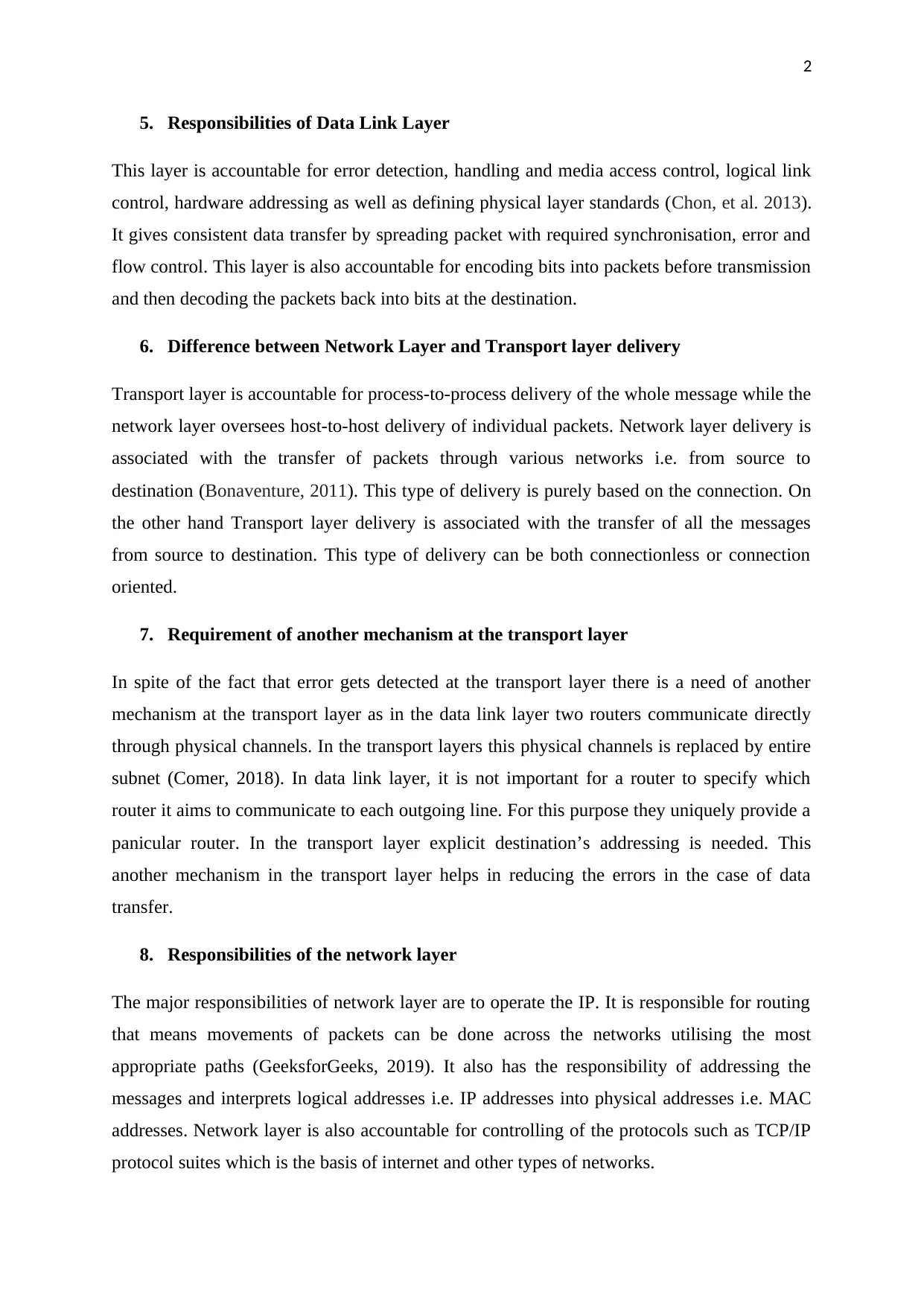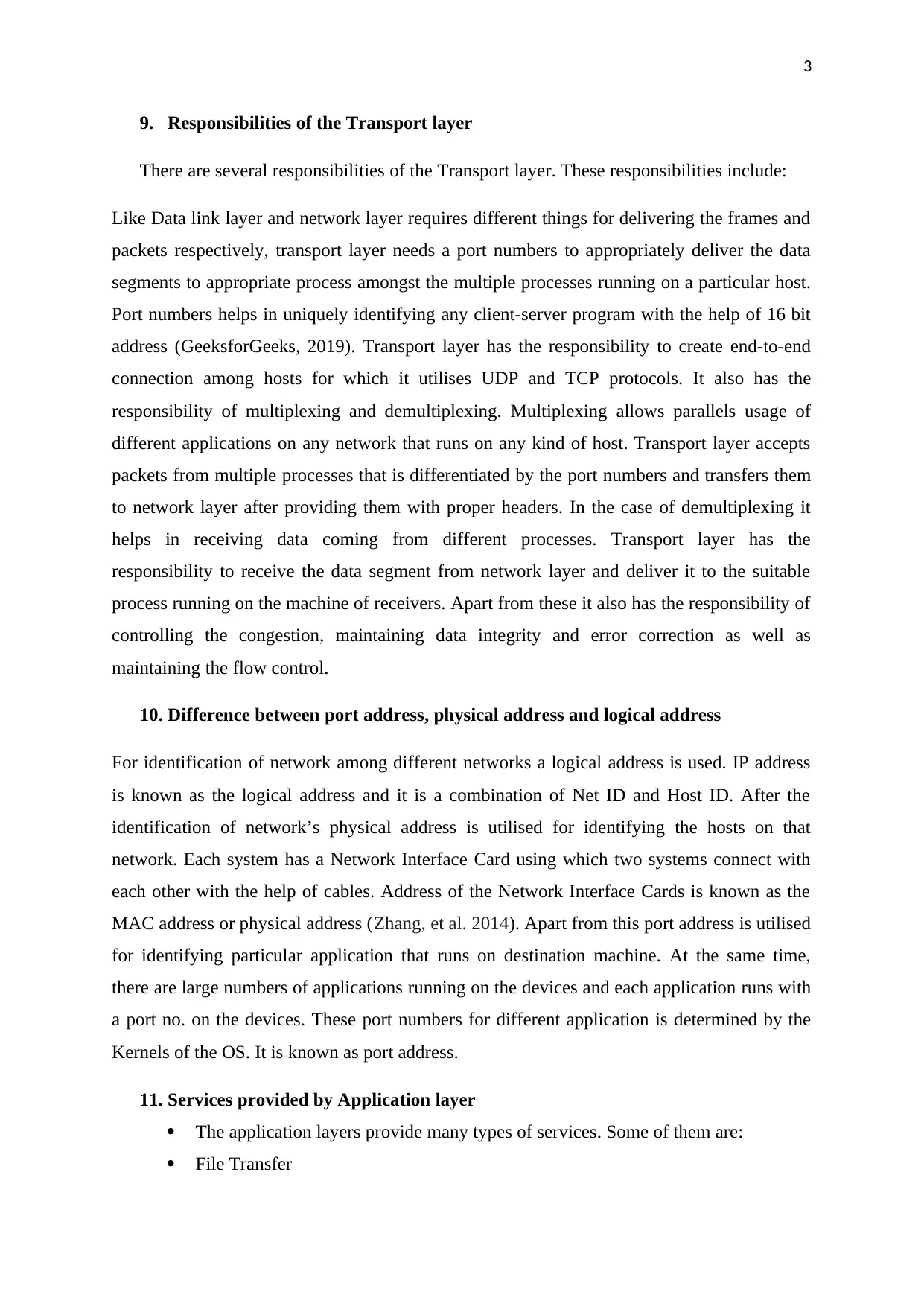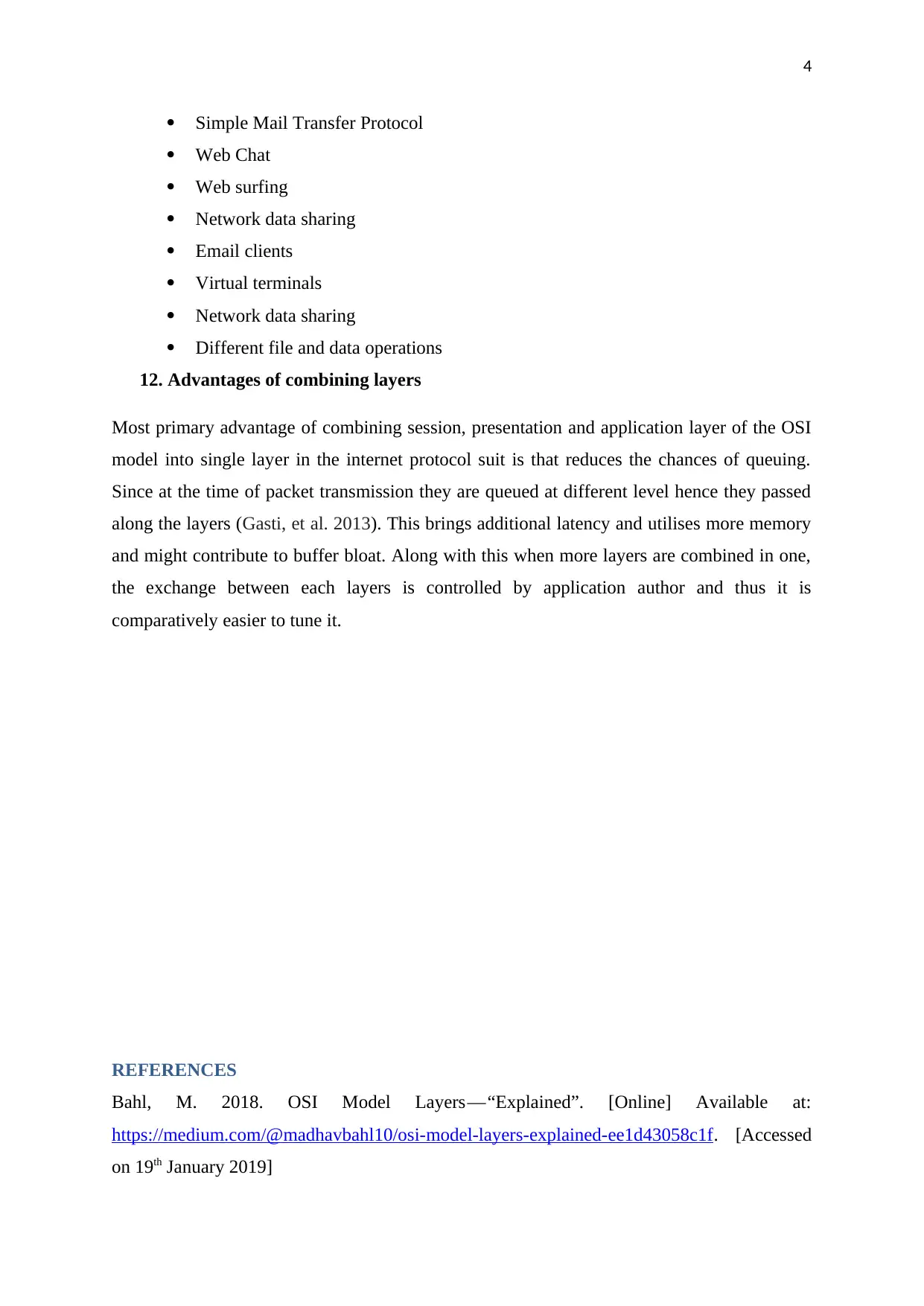Layers of OSI model and TCP/IP protocol suite
VerifiedAdded on 2023/04/23
|7
|1742
|74
AI Summary
This document explains the layers of OSI model and TCP/IP protocol suite, their correlation, responsibilities of data link layer, network layer and transport layer, data encapsulation, port address, logical address and physical address, services provided by application layer and advantages of combining layers.
Contribute Materials
Your contribution can guide someone’s learning journey. Share your
documents today.

Assignment 1
Secure Best Marks with AI Grader
Need help grading? Try our AI Grader for instant feedback on your assignments.

1
1. Layers of OSI model and TCP/IP protocol suite
Seven layers are present in OSI models. The layers from lowest to top most layers are
Physical layer, Data Link Layer, Network layer, Transport layer, Session layer, presentation
layer and application layer respectively (Bahl, 2018). On the other hand TCP/IP models have
4 layers namely Network Access/Link layer, Internet Layer, Host-to-Host/Transport layer and
Process/Application layer.
2. Correlation between layers of TCP/IP
There is a high correlation between different layers of both TCP/IP and OSI model. TCP/IP
model’s network layer is a mixture of Data link and Physical layer of the OSI model. Both
have the function to look out for addressing of hardware and the protocols used in this layers
permits physical delivery of data. The Internet layer in the TCP/IP internet suite corresponds
to the functionalities of Network layer in the OSI model. It describes the rules that are
accountable for logical delivery of data throughout the network (Robertazzi, 2011).
Host-to-Host layer in TCP/IP internet suite is similar to the transport layer in the OSI model.
It is accountable for error-free delivery of data and end-to-end communication. It safeguards
the upper-layer applications from the data complexity which is same as the responsibility of
the transport layer. Process layer is performing the function of OSI model’s three layer i.e.
Presentation layer, Session layer and application layer. It is accountable for point-to-point
communication and manipulates specifications related to user-interface.
3. Layers of TCP/IP protocol suite are network support layers
Network and Internet layers are the network support layers in the TCP/IP protocol suite. On
the other hand Process and Host-to-Host layers are the user support layers in this model.
4. Data encapsulation
Packets are the most basic unit of information which is transported throughout the network
which comprises of minimum numbers of headers having receiving and sending host
addresses and a body along with data that needs to be moved. When the packets travel
through the TCP/IP protocol stack, the each layer’s protocols either removes or adds fields
from the basic headers (Oracle, 2010). At the time when a protocol on the sending host adds
data to the packet header, the process is known as data encapsulation.
1. Layers of OSI model and TCP/IP protocol suite
Seven layers are present in OSI models. The layers from lowest to top most layers are
Physical layer, Data Link Layer, Network layer, Transport layer, Session layer, presentation
layer and application layer respectively (Bahl, 2018). On the other hand TCP/IP models have
4 layers namely Network Access/Link layer, Internet Layer, Host-to-Host/Transport layer and
Process/Application layer.
2. Correlation between layers of TCP/IP
There is a high correlation between different layers of both TCP/IP and OSI model. TCP/IP
model’s network layer is a mixture of Data link and Physical layer of the OSI model. Both
have the function to look out for addressing of hardware and the protocols used in this layers
permits physical delivery of data. The Internet layer in the TCP/IP internet suite corresponds
to the functionalities of Network layer in the OSI model. It describes the rules that are
accountable for logical delivery of data throughout the network (Robertazzi, 2011).
Host-to-Host layer in TCP/IP internet suite is similar to the transport layer in the OSI model.
It is accountable for error-free delivery of data and end-to-end communication. It safeguards
the upper-layer applications from the data complexity which is same as the responsibility of
the transport layer. Process layer is performing the function of OSI model’s three layer i.e.
Presentation layer, Session layer and application layer. It is accountable for point-to-point
communication and manipulates specifications related to user-interface.
3. Layers of TCP/IP protocol suite are network support layers
Network and Internet layers are the network support layers in the TCP/IP protocol suite. On
the other hand Process and Host-to-Host layers are the user support layers in this model.
4. Data encapsulation
Packets are the most basic unit of information which is transported throughout the network
which comprises of minimum numbers of headers having receiving and sending host
addresses and a body along with data that needs to be moved. When the packets travel
through the TCP/IP protocol stack, the each layer’s protocols either removes or adds fields
from the basic headers (Oracle, 2010). At the time when a protocol on the sending host adds
data to the packet header, the process is known as data encapsulation.

2
5. Responsibilities of Data Link Layer
This layer is accountable for error detection, handling and media access control, logical link
control, hardware addressing as well as defining physical layer standards (Chon, et al. 2013).
It gives consistent data transfer by spreading packet with required synchronisation, error and
flow control. This layer is also accountable for encoding bits into packets before transmission
and then decoding the packets back into bits at the destination.
6. Difference between Network Layer and Transport layer delivery
Transport layer is accountable for process-to-process delivery of the whole message while the
network layer oversees host-to-host delivery of individual packets. Network layer delivery is
associated with the transfer of packets through various networks i.e. from source to
destination (Bonaventure, 2011). This type of delivery is purely based on the connection. On
the other hand Transport layer delivery is associated with the transfer of all the messages
from source to destination. This type of delivery can be both connectionless or connection
oriented.
7. Requirement of another mechanism at the transport layer
In spite of the fact that error gets detected at the transport layer there is a need of another
mechanism at the transport layer as in the data link layer two routers communicate directly
through physical channels. In the transport layers this physical channels is replaced by entire
subnet (Comer, 2018). In data link layer, it is not important for a router to specify which
router it aims to communicate to each outgoing line. For this purpose they uniquely provide a
panicular router. In the transport layer explicit destination’s addressing is needed. This
another mechanism in the transport layer helps in reducing the errors in the case of data
transfer.
8. Responsibilities of the network layer
The major responsibilities of network layer are to operate the IP. It is responsible for routing
that means movements of packets can be done across the networks utilising the most
appropriate paths (GeeksforGeeks, 2019). It also has the responsibility of addressing the
messages and interprets logical addresses i.e. IP addresses into physical addresses i.e. MAC
addresses. Network layer is also accountable for controlling of the protocols such as TCP/IP
protocol suites which is the basis of internet and other types of networks.
5. Responsibilities of Data Link Layer
This layer is accountable for error detection, handling and media access control, logical link
control, hardware addressing as well as defining physical layer standards (Chon, et al. 2013).
It gives consistent data transfer by spreading packet with required synchronisation, error and
flow control. This layer is also accountable for encoding bits into packets before transmission
and then decoding the packets back into bits at the destination.
6. Difference between Network Layer and Transport layer delivery
Transport layer is accountable for process-to-process delivery of the whole message while the
network layer oversees host-to-host delivery of individual packets. Network layer delivery is
associated with the transfer of packets through various networks i.e. from source to
destination (Bonaventure, 2011). This type of delivery is purely based on the connection. On
the other hand Transport layer delivery is associated with the transfer of all the messages
from source to destination. This type of delivery can be both connectionless or connection
oriented.
7. Requirement of another mechanism at the transport layer
In spite of the fact that error gets detected at the transport layer there is a need of another
mechanism at the transport layer as in the data link layer two routers communicate directly
through physical channels. In the transport layers this physical channels is replaced by entire
subnet (Comer, 2018). In data link layer, it is not important for a router to specify which
router it aims to communicate to each outgoing line. For this purpose they uniquely provide a
panicular router. In the transport layer explicit destination’s addressing is needed. This
another mechanism in the transport layer helps in reducing the errors in the case of data
transfer.
8. Responsibilities of the network layer
The major responsibilities of network layer are to operate the IP. It is responsible for routing
that means movements of packets can be done across the networks utilising the most
appropriate paths (GeeksforGeeks, 2019). It also has the responsibility of addressing the
messages and interprets logical addresses i.e. IP addresses into physical addresses i.e. MAC
addresses. Network layer is also accountable for controlling of the protocols such as TCP/IP
protocol suites which is the basis of internet and other types of networks.

3
9. Responsibilities of the Transport layer
There are several responsibilities of the Transport layer. These responsibilities include:
Like Data link layer and network layer requires different things for delivering the frames and
packets respectively, transport layer needs a port numbers to appropriately deliver the data
segments to appropriate process amongst the multiple processes running on a particular host.
Port numbers helps in uniquely identifying any client-server program with the help of 16 bit
address (GeeksforGeeks, 2019). Transport layer has the responsibility to create end-to-end
connection among hosts for which it utilises UDP and TCP protocols. It also has the
responsibility of multiplexing and demultiplexing. Multiplexing allows parallels usage of
different applications on any network that runs on any kind of host. Transport layer accepts
packets from multiple processes that is differentiated by the port numbers and transfers them
to network layer after providing them with proper headers. In the case of demultiplexing it
helps in receiving data coming from different processes. Transport layer has the
responsibility to receive the data segment from network layer and deliver it to the suitable
process running on the machine of receivers. Apart from these it also has the responsibility of
controlling the congestion, maintaining data integrity and error correction as well as
maintaining the flow control.
10. Difference between port address, physical address and logical address
For identification of network among different networks a logical address is used. IP address
is known as the logical address and it is a combination of Net ID and Host ID. After the
identification of network’s physical address is utilised for identifying the hosts on that
network. Each system has a Network Interface Card using which two systems connect with
each other with the help of cables. Address of the Network Interface Cards is known as the
MAC address or physical address (Zhang, et al. 2014). Apart from this port address is utilised
for identifying particular application that runs on destination machine. At the same time,
there are large numbers of applications running on the devices and each application runs with
a port no. on the devices. These port numbers for different application is determined by the
Kernels of the OS. It is known as port address.
11. Services provided by Application layer
The application layers provide many types of services. Some of them are:
File Transfer
9. Responsibilities of the Transport layer
There are several responsibilities of the Transport layer. These responsibilities include:
Like Data link layer and network layer requires different things for delivering the frames and
packets respectively, transport layer needs a port numbers to appropriately deliver the data
segments to appropriate process amongst the multiple processes running on a particular host.
Port numbers helps in uniquely identifying any client-server program with the help of 16 bit
address (GeeksforGeeks, 2019). Transport layer has the responsibility to create end-to-end
connection among hosts for which it utilises UDP and TCP protocols. It also has the
responsibility of multiplexing and demultiplexing. Multiplexing allows parallels usage of
different applications on any network that runs on any kind of host. Transport layer accepts
packets from multiple processes that is differentiated by the port numbers and transfers them
to network layer after providing them with proper headers. In the case of demultiplexing it
helps in receiving data coming from different processes. Transport layer has the
responsibility to receive the data segment from network layer and deliver it to the suitable
process running on the machine of receivers. Apart from these it also has the responsibility of
controlling the congestion, maintaining data integrity and error correction as well as
maintaining the flow control.
10. Difference between port address, physical address and logical address
For identification of network among different networks a logical address is used. IP address
is known as the logical address and it is a combination of Net ID and Host ID. After the
identification of network’s physical address is utilised for identifying the hosts on that
network. Each system has a Network Interface Card using which two systems connect with
each other with the help of cables. Address of the Network Interface Cards is known as the
MAC address or physical address (Zhang, et al. 2014). Apart from this port address is utilised
for identifying particular application that runs on destination machine. At the same time,
there are large numbers of applications running on the devices and each application runs with
a port no. on the devices. These port numbers for different application is determined by the
Kernels of the OS. It is known as port address.
11. Services provided by Application layer
The application layers provide many types of services. Some of them are:
File Transfer
Secure Best Marks with AI Grader
Need help grading? Try our AI Grader for instant feedback on your assignments.

4
Simple Mail Transfer Protocol
Web Chat
Web surfing
Network data sharing
Email clients
Virtual terminals
Network data sharing
Different file and data operations
12. Advantages of combining layers
Most primary advantage of combining session, presentation and application layer of the OSI
model into single layer in the internet protocol suit is that reduces the chances of queuing.
Since at the time of packet transmission they are queued at different level hence they passed
along the layers (Gasti, et al. 2013). This brings additional latency and utilises more memory
and might contribute to buffer bloat. Along with this when more layers are combined in one,
the exchange between each layers is controlled by application author and thus it is
comparatively easier to tune it.
REFERENCES
Bahl, M. 2018. OSI Model Layers — “Explained”. [Online] Available at:
https://medium.com/@madhavbahl10/osi-model-layers-explained-ee1d43058c1f. [Accessed
on 19th January 2019]
Simple Mail Transfer Protocol
Web Chat
Web surfing
Network data sharing
Email clients
Virtual terminals
Network data sharing
Different file and data operations
12. Advantages of combining layers
Most primary advantage of combining session, presentation and application layer of the OSI
model into single layer in the internet protocol suit is that reduces the chances of queuing.
Since at the time of packet transmission they are queued at different level hence they passed
along the layers (Gasti, et al. 2013). This brings additional latency and utilises more memory
and might contribute to buffer bloat. Along with this when more layers are combined in one,
the exchange between each layers is controlled by application author and thus it is
comparatively easier to tune it.
REFERENCES
Bahl, M. 2018. OSI Model Layers — “Explained”. [Online] Available at:
https://medium.com/@madhavbahl10/osi-model-layers-explained-ee1d43058c1f. [Accessed
on 19th January 2019]

5
Bonaventure, O., 2011. Computer Networking: Principles, Protocols and Practice (pp. 41-
45). Textbook Equity Edition.
Chon, K., Park, H.J., Hur, J.H. and Kang, K., 2013. A history of computer networking and
the internet in Korea [History of Communications]. IEEE Communications Magazine, 51(2),
pp.10-15.
Comer, D.E., 2018. The Internet book: everything you need to know about computer
networking and how the Internet works. Chapman and Hall/CRC.
Gasti, P., Tsudik, G., Uzun, E. and Zhang, L., 2013, July. DoS and DDoS in named data
networking. In Computer Communications and Networks (ICCCN), 2013 22nd International
Conference on (pp. 1-7). IEEE.
GeeksforGeeks, 2019. Computer Network | TCP/IP Model. [Online] Available at:
https://www.geeksforgeeks.org/computer-network-tcpip-model/. [Accessed on 19th January
2019]
GeeksforGeeks, 2019. Computer Network | Transport Layer responsibilities. [Online]
Available at: https://www.geeksforgeeks.org/computer-network-transport-layer-
responsibilities/. [Accessed on 19th January 2019]
Oracle, 2010. Data Encapsulation and the TCP/IP Protocol Stack. [Online] Available at:
https://docs.oracle.com/cd/E19455-01/806-0916/ipov-32/index.html. [Accessed on 19th
January 2019]
Robertazzi, T., 2011. Basics of computer networking. Springer Science & Business Media.
Zhang, L., Afanasyev, A., Burke, J., Jacobson, V., Crowley, P., Papadopoulos, C., Wang, L.
and Zhang, B., 2014. Named data networking. ACM SIGCOMM Computer Communication
Review, 44(3), pp.66-73.
Bonaventure, O., 2011. Computer Networking: Principles, Protocols and Practice (pp. 41-
45). Textbook Equity Edition.
Chon, K., Park, H.J., Hur, J.H. and Kang, K., 2013. A history of computer networking and
the internet in Korea [History of Communications]. IEEE Communications Magazine, 51(2),
pp.10-15.
Comer, D.E., 2018. The Internet book: everything you need to know about computer
networking and how the Internet works. Chapman and Hall/CRC.
Gasti, P., Tsudik, G., Uzun, E. and Zhang, L., 2013, July. DoS and DDoS in named data
networking. In Computer Communications and Networks (ICCCN), 2013 22nd International
Conference on (pp. 1-7). IEEE.
GeeksforGeeks, 2019. Computer Network | TCP/IP Model. [Online] Available at:
https://www.geeksforgeeks.org/computer-network-tcpip-model/. [Accessed on 19th January
2019]
GeeksforGeeks, 2019. Computer Network | Transport Layer responsibilities. [Online]
Available at: https://www.geeksforgeeks.org/computer-network-transport-layer-
responsibilities/. [Accessed on 19th January 2019]
Oracle, 2010. Data Encapsulation and the TCP/IP Protocol Stack. [Online] Available at:
https://docs.oracle.com/cd/E19455-01/806-0916/ipov-32/index.html. [Accessed on 19th
January 2019]
Robertazzi, T., 2011. Basics of computer networking. Springer Science & Business Media.
Zhang, L., Afanasyev, A., Burke, J., Jacobson, V., Crowley, P., Papadopoulos, C., Wang, L.
and Zhang, B., 2014. Named data networking. ACM SIGCOMM Computer Communication
Review, 44(3), pp.66-73.

6
1 out of 7
Related Documents
Your All-in-One AI-Powered Toolkit for Academic Success.
+13062052269
info@desklib.com
Available 24*7 on WhatsApp / Email
![[object Object]](/_next/static/media/star-bottom.7253800d.svg)
Unlock your academic potential
© 2024 | Zucol Services PVT LTD | All rights reserved.




